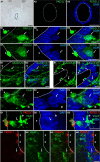Investigation of spinal cerebrospinal fluid-contacting neurons expressing PKD2L1: evidence for a conserved system from fish to primates
- PMID: 24834029
- PMCID: PMC4018565
- DOI: 10.3389/fnana.2014.00026
Investigation of spinal cerebrospinal fluid-contacting neurons expressing PKD2L1: evidence for a conserved system from fish to primates
Abstract
Over 90 years ago, Kolmer and Agduhr identified spinal cerebrospinal fluid-contacting neurons (CSF-cNs) based on their morphology and location within the spinal cord. In more than 200 vertebrate species, they observed ciliated neurons around the central canal that extended a brush of microvilli into the cerebrospinal fluid (CSF). Although their morphology is suggestive of a primitive sensory cell, their function within the vertebrate spinal cord remains unknown. The identification of specific molecular markers for these neurons in vertebrates would benefit the investigation of their physiological roles. PKD2L1, a transient receptor potential channel that could play a role as a sensory receptor, has been found in cells contacting the central canal in mouse. In this study, we demonstrate that PKD2L1 is a specific marker for CSF-cNs in the spinal cord of mouse (Mus musculus), macaque (Macaca fascicularis) and zebrafish (Danio rerio). In these species, the somata of spinal PKD2L1(+) CSF-cNs were located below or within the ependymal layer and extended an apical bulbous extension into the central canal. We found GABAergic PKD2L1-expressing CSF-cNs in all three species. We took advantage of the zebrafish embryo for its transparency and rapid development to identify the progenitor domains from which pkd2l1 (+) CSF-cNs originate. pkd2l1 (+) CSF-cNs were all GABAergic and organized in two rows-one ventral and one dorsal to the central canal. Their location and marker expression is consistent with previously described Kolmer-Agduhr cells. Accordingly, pkd2l1 (+) CSF-cNs were derived from the progenitor domains p3 and pMN defined by the expression of nkx2.2a and olig2 transcription factors, respectively. Altogether our results suggest that a system of CSF-cNs expressing the PKD2L1 channel is conserved in the spinal cord across bony vertebrate species.
Keywords: GABAergic neurons; PKD2L1; cerebrospinal fluid-contacting neurons (CSF-cNs); macaque; mouse; spinal cord; zebrafish.
Figures








References
-
- Agduhr E. (1922). Über ein Zentrales Sinnesorgan (?) bei den Vertebraten. Z. Anat. Entwicklungs. 66, 223–360 10.1007/BF02593586 - DOI
-
- Basora N., Nomura H., Berger U. V., Stayner C., Guo L., Shen X., et al. (2002). Tissue and cellular localization of a novel polycystic kidney disease-like gene product, polycystin-L. J. Am. Soc. Nephrol. 13, 293–301 - PubMed
LinkOut - more resources
Full Text Sources
Other Literature Sources
Molecular Biology Databases

